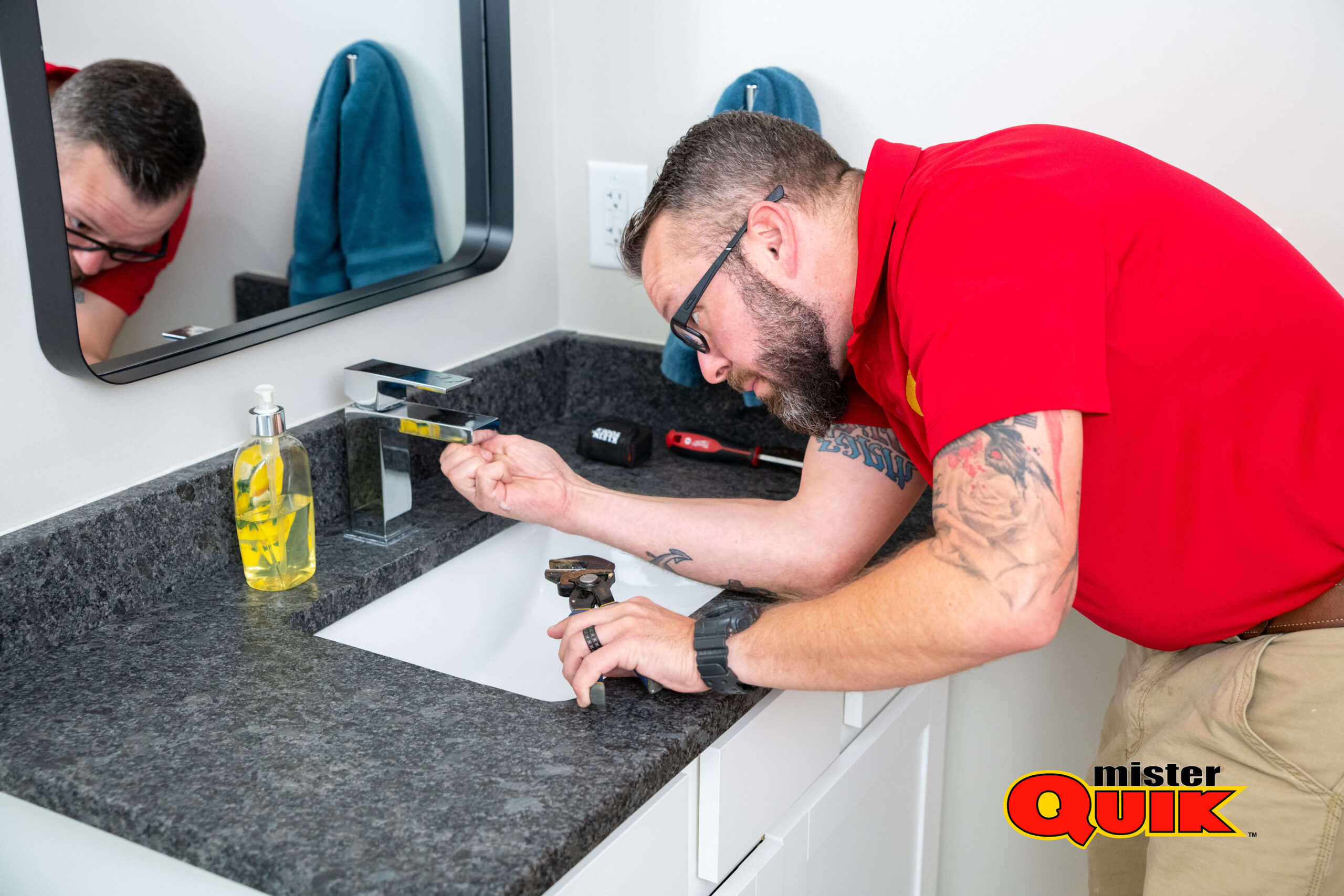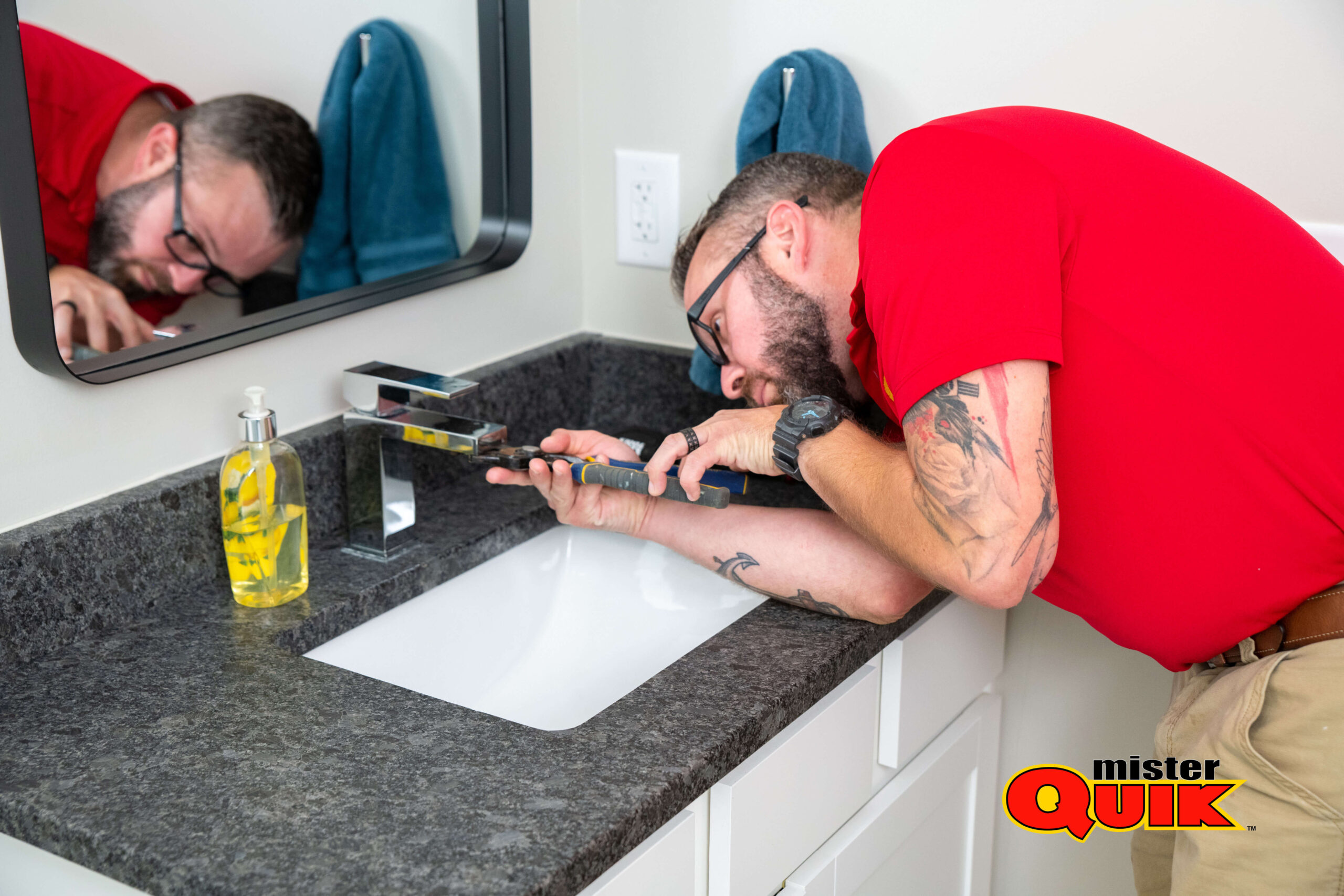Bloomington Faucets

Installing Bloomington Faucets
The faucet in your bathroom sink is one of the most used fixtures in your home. Over time, even the most durable faucets can wear out, develop leaks, or simply become outdated. If you’re facing a dripping faucet or want to update your bathroom’s style, a new faucet installation might be the answer!
This guide will walk you through the steps involved in replacing a bathroom faucet in Bloomington, Indiana.
Before You Begin:
Gather your tools: You’ll need adjustable wrenches, a basin wrench (optional), screwdrivers (flathead and Phillips), bucket, plumber’s tape, and rags.
Purchase your new faucet: Choose a faucet that fits your sink and has the desired features (single handle, double handle, etc.). Ensure it complies with local plumbing codes in Bloomington.
Turn off the water supply: Locate the shut-off valves under your sink and turn them clockwise until the water supply is completely off. You can test this by turning on the faucet; no water should flow.
Clear the work area: Remove any items under the sink that might be in the way.
Steps to Replacing your Bloomington Bathroom Faucet:
Disconnect the old faucet:
Use an adjustable wrench to loosen the nuts connecting the faucet supply lines to the shut-off valves.
Hold the nuts with another wrench to prevent them from spinning.
Place the bucket under the connections to catch any dripping water.
Once loose, detach the supply lines from the shut-off valves.
Remove the old faucet:
If your faucet has a single mounting nut, use an adjustable wrench to loosen it from underneath the sink.
If it has multiple nuts, locate them and loosen them accordingly.
Carefully lift the old faucet out of the sink.
Install the new faucet:
Place the new faucet into the sink hole and insert the mounting nuts from underneath.
Tighten the nuts securely, but be careful not to over-tighten and crack the sink.
Tip: Hand-tighten first, then use the wrench for a final snug fit.
Connect the supply lines:
Wrap a few layers of plumber’s tape around the threads of each supply line.
Screw the supply lines onto the corresponding hot and cold water shut-off valves.
Tighten the connections using wrenches, holding the valve body with one wrench and tightening the nut with the other.
By following these steps and using a bit of caution, you can successfully replace your Bloomington bathroom faucet and enjoy a refreshed and functional bathroom fixture!
Moen Delta Faucets Kohler American Standard Toto Mansfield Plumbing Price Pfister Peerless Lochinvar Rinnai Navien Grohe Speakman Gerber Whirlpool Easywater AO Smith Rheem Bradford White Culligan Kinetico Sterling Brizo Gastite Zoeller Glentronics Zurn Grundfos Pumps Blanco Bocchi Bradley Company Brasscraft Manufacturing Company Kerox, Ltd. Dornbracht Americas Inc. Falcon Water Technologies, LLC Fisher Manufacturing Company Fluidmaster, Inc. Hansgrohe, Inc. Haws Corporation LAUFEN Schweiz AG Lavelle Industries, Inc. LIXIL LSP Products Group LLC Marcone Plumbing Masco Corporation Neoperl, Inc. Reliance Worldwide Corporation Sloan Valve Company Sprite Industries T&S Brass and Bronze Works, Inc. Uponor Viega LLC Water Pik, Inc. WCM Industries, Inc.
Axor Decolav Dreamline Showers DXV Fairmont Design Fortis Franke Geberit Plumbing Ginger Graff HydroSystems Infinity Drains In-Sink-Erator Jacuzzi James Martin LinkaSink MTI Native Trails Newport Brass PROFLO Rohl Signature Hardware Strasser Swanstone Thompson Traders Watermark Zucchetti Alfi ANZZI Altair AquaPure Avanity Avano Azzuri Bella CORE Bemis Brondell CRAFT + MAIN California Faucets Chicago Faucets Clarke Cutler Kitchen and Bath Duravit EAGO Eccotemp Eemax Fresca Giagni Houzer Jones Stephens Kaldewei Kingston BrassKraus Liberty Pumps Little Giant MediTub Nameeks OVE Decors Pulse Purewater Baths Sagehill Designs Saniflo Stiebel Eltron Swiss Madison Symmons Ultra Faucets VIGO WS Bath Collections Waste King Watts Whitehaus
Fixing a leaky faucet
At Mister Quik Home Services in Indianapolis, we understand the frustration and inconvenience that arise when a sump pump malfunctions. Here are some common sump pump problems homeowners may encounter and how our expert team can help:
Sump pumps rely on electricity to function properly, so power outages can leave your basement vulnerable to flooding. Installing a battery backup system ensures your sump pump continues working during power failures, providing uninterrupted protection.
The switch is a critical component that triggers the sump pump to turn on and off as needed. Problems with the switch, such as being stuck in the "on" or "off" position, can prevent the pump from activating or shutting off when necessary. Our technicians can repair or replace faulty switches to restore proper functionality.
Over time, debris, sediment, or ice can accumulate in the discharge pipe, obstructing the flow of water. Regular maintenance, including clearing debris from the discharge pipe and ensuring proper drainage away from the house, can prevent clogs and keep your sump pump operating efficiently.
During heavy rainfall or rapid snowmelt, sump pumps may become overwhelmed with the volume of water entering the sump pit. Upgrading to a larger capacity sump pump or installing a secondary pump can help manage higher water levels and prevent overload situations.
When selecting a faucet, consider the style and aesthetic of your bathroom or kitchen, opting for a design that complements the existing decor. Determine the mounting style that suits your sink configuration, whether deck-mounted or wall-mounted. Choose features that match your needs, such as pull-down or pull-out spray heads for kitchen faucets or touchless operation for added convenience in the bathroom. Coordinate the finish with other fixtures in the room, ensuring durability by selecting high-quality materials like brass or stainless steel. Set a budget and prioritize features and quality within your price range.
A bathroom faucet should typically reach about 4 to 7 inches (10 to 18 centimeters) beyond the edge of the sink. This distance ensures that the water stream falls comfortably into the center of the sink basin, allowing for easy handwashing and minimizing splashing onto the countertop. However, the exact reach of the faucet can vary depending on factors such as the size and shape of the sink, the faucet design, and personal preference.
The best type of faucet valve depends on factors such as durability, reliability, ease of maintenance, and personal preference. Several common types of faucet valves include compression valves, ball valves, cartridge valves, and ceramic disk valves. Compression valves are traditional but prone to wear and dripping over time. Ball valves offer smooth operation and are less prone to leaks. Cartridge valves are durable, reliable, and easy to maintain, suitable for both single-handle and double-handle faucets. Ceramic disk valves are highly durable, resistant to wear and tear, and provide smooth operation with minimal maintenance, often found in high-end faucets.
No, not all bathroom faucets fit all sinks. The compatibility of a faucet with a sink depends on several factors, including the mounting configuration, hole spacing, and size of the sink. Bathroom faucets come in various mounting styles, such as single-hole, centerset, widespread, and wall-mounted, each requiring a specific hole configuration in the sink or countertop. Additionally, the distance between the holes (if applicable) must match the faucet’s spout and handle spread.
The most common type of bathroom sink faucet is the centerset faucet. Centerset faucets feature a single spout and two handles mounted on a single base, typically spaced 4 inches apart. These faucets are designed for sinks with pre-drilled holes spaced 4 inches apart, making them a popular choice for standard bathroom sink installations. Centerset faucets are available in a wide range of styles and finishes, making them versatile and suitable for various bathroom designs. Additionally, centerset faucets are relatively easy to install and maintain, contributing to their widespread popularity in residential bathrooms.
Leaky faucet bathtub
That constant drip, drip, drip from your bathroom faucet can be more than just annoying. It can also waste water and money, driving up your utility bills. Luckily, fixing a leaky faucet is often a straightforward task that you can tackle yourself with a little know-how and the right tools.


- Turn off the water supply: Locate the shut-off valve under your sink. It’s usually a knob or handle that turns clockwise to shut off the water.
- Gather your tools: You’ll likely need a few basic tools like an adjustable wrench, screwdriver (flathead and Phillips), pliers, and possibly a basin wrench for tight spaces.
- Handle: If the leak is around the base of the handle, it’s likely a worn-out washer.
- Spout: If water is dripping from the spout itself, the issue might be with the cartridge or a loose connection.
- Base: Leaks at the base of the faucet usually indicate a problem with the valve body or its connections.
- Remove the handle: This usually involves using a small Allen wrench or screwdriver to loosen a screw hidden under the handle cap.
- Replace the washer: The washer is a small rubber ring that creates a seal against the valve stem. Find a replacement washer that matches your faucet model and replace the old one.
- Reassemble the handle: Tighten the screw and ensure the handle turns smoothly without leaking.
- Remove the spout: Depending on the faucet type, you might need to remove a retaining nut or use an Allen wrench to detach the spout.
- Replace the cartridge: The cartridge is the heart of the faucet and controls water flow. Locate the replacement cartridge that matches your faucet model and follow the manufacturer’s instructions for installation.
- Reattach the spout: Tighten any connections securely.
Bathroom faucet installation near me
A leaky or outdated faucet can be a real drag in your bathroom. Not only is it frustrating to deal with drips and low water pressure, but it can also affect the overall look and feel of your space. If you’re thinking about upgrading your bathroom faucet in Bloomington, you’re in luck!
There are many factors to consider when choosing a new faucet, and it’s important to find one that meets your needs and style. Here’s a quick guide to help you through the process:


Centerset faucets: These are the most common type of faucet, with two handles (one for hot water, one for cold) mounted on a single base plate. Widespread faucets: These faucets have three separate pieces – the spout and two handles – which allows for more flexibility in placement. Wall-mounted faucets: These faucets are mounted directly to the wall behind the sink, creating a sleek and modern look. Pull-down/pull-out faucets: These faucets feature a spray head that can be pulled down or out for easier cleaning and rinsing.


Consider your budget: Bathroom faucets come in a wide range of prices, so it's important to set a budget before you start shopping. Think about style: Do you prefer a traditional or modern look? There are many different styles of faucets available to match your bathroom décor. Functionality: How do you use your bathroom sink? If you do a lot of hand washing or cleaning, you might want a faucet with a spray head.


Get recommendations: Ask friends, family, or neighbors for recommendations for a reputable plumber. Read online reviews: Check online review sites to see what other people have experienced with different plumbers. Get quotes: Get quotes from several different plumbers before you make a decision.
Faucet repair service near Bloomington
A leaky faucet might seem like a minor nuisance, but it can waste a surprising amount of water over time. Plus, the constant drip-drip-drip can be quite bothersome! If you’re facing a faucet malfunction in your Bloomington home, don’t despair. This guide will help you understand common faucet problems and point you in the right direction for repairs.
Common Bathroom Faucet Issues:
- Dripping: This is often caused by worn-out washers or seals within the faucet.
- Low water pressure: Mineral buildup or clogged aerators can restrict water flow.
- Loose handles: This could be due to a loose screw or worn-out cartridge.
- Sprayer issues: If your faucet has a sprayer function, it might malfunction due to a broken hose or clogged nozzle.
Finding a Reputable Plumber in Bloomington:
When searching for a plumber, it’s crucial to choose a licensed and insured professional. Here are some tips:
- Ask for recommendations: Talk to friends, family, or neighbors for reliable referrals.
- Check online reviews: Read online reviews and testimonials to get a sense of past customer experiences with different plumbers.
- Get quotes: Contact several plumbers and compare their rates and services offered.
- Ask about warranties: Ensure the plumber offers a warranty on their work for peace of mind.
Preventing Future Faucet Woes:
- Regular cleaning: Regularly clean your faucets with a mild soap and water solution to remove mineral buildup.
- Inspect the aerator: Unscrew the aerator and clean it periodically to maintain good water pressure.
- Gentle use: Avoid applying excessive force to the faucet handles.
- Schedule professional maintenance: Consider professional maintenance checks every few years to identify potential issues early on.
Faucet valve replacement cost in Bloomington
A leaky faucet – those pesky drips, drips, drips – can be more than just an annoyance. It can waste water, driving up your utility bills, and even lead to potential water damage down the line. If your once-faithful bathroom faucet is giving up the ghost, you might be wondering about the cost of replacing its valve.
Here’s a breakdown of what factors can influence the cost of replacing a bathroom faucet valve in Bloomington:
Single-handle faucets: These are generally the most affordable option for valve replacement. Double-handle faucets: Replacing valves in these faucets might cost slightly more due to the additional hardware involved. Widespread faucets: These faucets have separate handles for hot and cold water, and valve replacement might cost a bit more than single-handle faucets due to the potential for more complex plumbing configurations.
Compression valves: These are the most common type of valve, and replacement is usually the most affordable option. Cartridge valves: Replacing these valves can be slightly more expensive than compression valves, but they generally offer a smoother operation and longer lifespan. Ceramic disc valves: These are known for their durability and smooth operation, but replacing them can be the most expensive option
The complexity of the job and the plumber's experience can affect the labor cost. If the faucet is easy to access and the valve replacement is straightforward, the labor cost will likely be lower. Conversely, if the faucet is difficult to access or requires additional work, such as removing old, corroded parts, the labor cost might be higher.
Disposal of the old faucet: Some plumbers may charge a disposal fee for removing and disposing of the old faucet. Emergency service: If you need the valve replaced urgently outside of regular business hours, there might be an additional fee for emergency service.
It's important to remember that these are just general cost estimations. The actual cost of replacing a bathroom faucet valve in Bloomington can vary depending on the factors mentioned above. To get a more accurate estimate, it's always best to consult with a licensed plumber in your area. They can assess your specific situation and provide you with a personalized quote.
While cost is certainly a factor to consider, it’s also important to remember the long-term benefits of repairing a leaky faucet. Not only will you save water and money on your utility bills, but you’ll also prevent potential water damage and the associated repair costs.
By understanding the factors that influence the cost of faucet valve replacement and getting quotes from qualified plumbers, you can make an informed decision about how to address your leaky faucet situation in Bloomington.
Troubleshoot Checklist:
- Turn off the shut-off valves: Locate the valves under the sink and turn them clockwise until they stop.
- Check for city water: Ensure there are no disruptions in your area by contacting your water provider or checking online alerts.
Tighten the handle screw: Look for a screw at the base of the handle and use a screwdriver to tighten it gently.
Check for handle damage: Look for cracks, loose parts, or misalignment that might hinder proper operation.
- Identify the source: Check for leaks around the base of the faucet, at the connections, or from the spray hose.
- Tighten loose connections: Use appropriate tools to tighten any loose nuts or fittings around the faucet.
- Clean the spray head: Remove any mineral build-up or debris that might be blocking the spray pattern.
- Check the hose connection: Ensure the hose is securely attached to the faucet and not leaking at the connection point.
- Persistent leaks: If leaks persist after tightening connections and checking the handle, the cartridge might be worn and need replacing.
- Reduced water pressure: A faulty cartridge can also lead to reduced water pressure.











